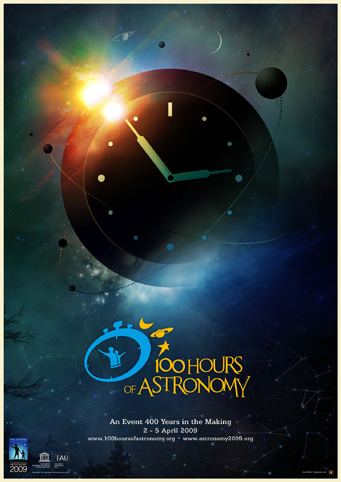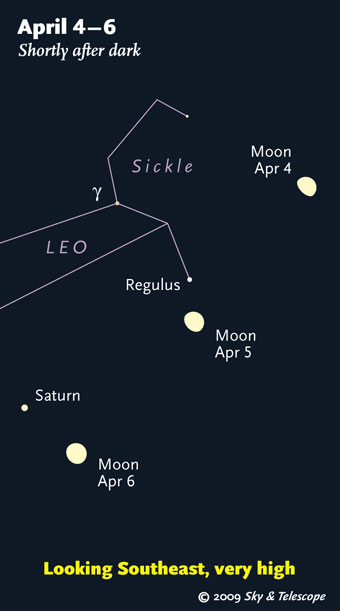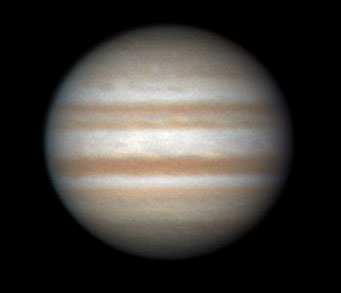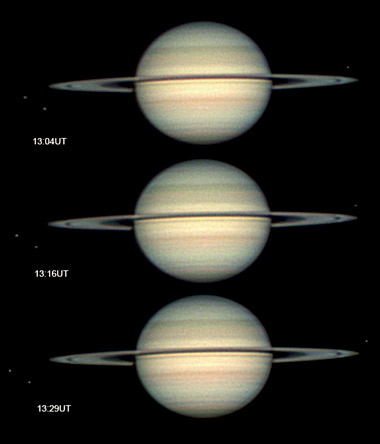Some daily events in the changing sky for April 3 – 11.
Comet Yi-SWAN may not be much at magnitude 8½, but it's far north crossing the bright pattern of Cassiopeia this week. For now it's about equally high in the northwest just after dusk and in the northeast just before the first light of dawn. Choose your time to avoid moonlight if possible. (Full Moon is April 9th.) See our AstroAlert with positions for plotting on your star atlas.

James White/signalnoise.com / IAU / IYA
Friday, April 3
Saturday, April 4

The Moon is waxing gibbous as it passes Regulus and Saturn. The view is drawn for the middle of North America. European observers: move each Moon symbol a quarter of the way toward the one for the previous date. In the Far East, move it halfway.
Sky & Telescope
The Moon after dusk forms a straight, diagonal line with Regulus and Saturn at its lower left, as shown at right.
Sunday, April 5
Monday, April 6
Tuesday, April 7
Wednesday, April 8
Thursday, April 9
Friday, April 10
Saturday, April 11
Want to become a better amateur astronomer? Learn your way around the constellations. They're the key to locating everything fainter and deeper to hunt with binoculars or a telescope. For an easy-to-use constellation guide covering the whole evening sky, use the big monthly map in each issue of Sky & Telescope, the essential magazine of astronomy. Or download our free Getting Started in Astronomy booklet (which only has bimonthly maps).

The Pocket Sky Atlas plots 30,796 stars to magnitude 7.6 — which may sound like a lot, but that's less than one star in an entire telescopic field of view, on average. By comparison, Sky Atlas 2000.0 plots 81,000 stars to magnitude 8.5, typically one or two stars per telescopic field. Both atlases include many hundreds of deep-sky targets — galaxies, star clusters, and nebulae — among the stars.
Sky & Telescope
Once you get a telescope, to put it to good use you'll need a detailed, large-scale sky atlas (set of charts; the standards are Sky Atlas 2000.0 or the smaller Pocket Sky Atlas) and good deep-sky guidebooks (such as Sky Atlas 2000.0 Companion by Strong and Sinnott, the even more detailed Night Sky Observer's Guide by Kepple and Sanner, or the classic Burnham's Celestial Handbook). Read how to use them effectively.
Can a computerized telescope take their place? As Terence Dickinson and Alan Dyer say in their Backyard Astronomer's Guide, "A full appreciation of the universe cannot come without developing the skills to find things in the sky and understanding how the sky works. This knowledge comes only by spending time under the stars with star maps in hand and a curious mind." Without these, they note, "the sky never becomes a friendly place."
More beginners' tips: "How to Start Right in Astronomy".
This Week's Planet Roundup

It's starting to be Jupiter season again — if you get up before dawn and have a good view low to the southeast. About this picture, Christopher Go in the Philippines writes: "Jupiter was only around 20° above the horizon when I imaged this morning. Seeing was good for this altitude. Jupiter seems to have quieted down. Oval BA ['Red Spot Junior'] is visible [indistinctly] on the upper left. But its color is a paler than last year. Will it turn white this year? Who knows. . . ."
South is up. "The [double] South Equatorial Belt and the North Equatorial Belt are the same dark red color. The mid-SEB section is very busy. The Equatorial Zone looks quiet with little festoon activity. The NEB is also devoid of activity. It is just dark red. The North Temperate Belt is distinct. The polar regions are dark."
Christopher Go
Mercury is emerging from the glow of sunset. By late this week, you should be able to spot it glimmering (at about magnitude –1.5) low above the western horizon 30 or 40 minutes after sunset.
Venus (magnitude –4.2) is low in the dawn. Look for it above the eastern horizon about 20 or 30 minutes before sunrise. Don't confuse it with Jupiter higher and far to the right in the southeast. (You can find your local sunrise time from our online almanac. If you're on daylight saving time like most of North America, make sure the Daylight Saving Time box is checked). In a telescope, Venus is a slim crescent.
Mars (magnitude +1.2) is both dim and very low in the sunrise glow. Using big binoculars, you can try looking for it well to the right of Venus about 30 minutes before sunrise. Good luck.
Jupiter (magnitude –2.1, in Capricornus) shines low in the southeast during early dawn.

On March 25th, Christopher Go imaged Saturn and three of its moons during excellent seeing. Dione and Tethys are on the left, and fast-moving little Enceladus is just above the rings' tip on the right. North is up, and celestial east is left.
Go writes, "The band details are again excellent in this image. The South Equatorial Belt is well resolved. The North Equatorial Belt is still rather dull. There is a lot of banding in the South Polar Region."
Christopher Go
Saturn (magnitude +0.6, near the hind foot of Leo) shines in the southeast at dusk. It's highest in the south around 10 or 11 p.m. Look for Regulus 16° (roughly one and a half fist-widths at arm's length) to Saturn's upper right in early evening, and more directly to its right later at night.
In a telescope, Saturn's rings are 3½° from edge on. The rings will open to a maximum of 4° in May, then will close to exactly edge-on next September 4th — when, unfortunately, Saturn will be out of sight practically in conjunction with the Sun.
Uranus (6th magnitude) is hidden low in the sunrise glow, in the background of Venus and Mars.
Neptune (8th magnitude) is also hidden in the glow of dawn, in the background of Jupiter.
Pluto (14th magnitude, in northwestern Sagittarius) is located in the southeast before the first light of dawn.
All descriptions that relate to your horizon or zenith — including the words up, down, right, and left — are written for the world's mid-northern latitudes. Descriptions that also depend on longitude (mainly Moon positions) are for North America. Eastern Daylight Time (EDT) equals Universal Time (known as UT, UTC, or GMT) minus 4 hours.
To be sure to get the current Sky at a Glance, bookmark this URL:
http://SkyandTelescope.com/observing/ataglance?1=1
If pictures fail to load, refresh the page. If they still fail to load, change the 1 at the end of the URL to any other character and try again.
 0
0
Comments
You must be logged in to post a comment.